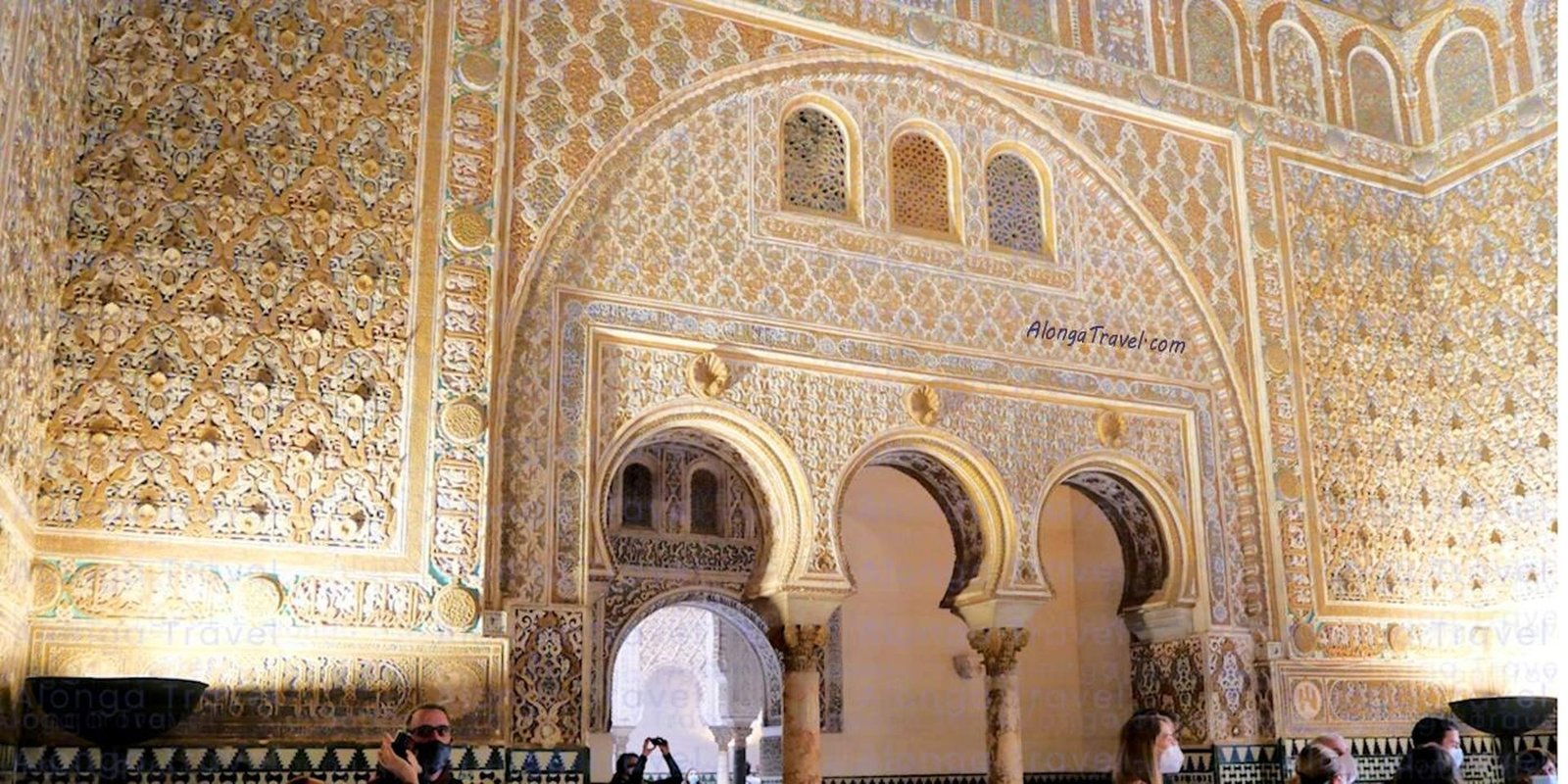Mudejar architecture – an unexpected blend of architecture that looks exotic
Mudejar architecture is an exotic style that emerged in the former Iberian Peninsula (modern Spain and Portugal) after the Reconquista. This style is a blend of the beauty of Islamic and Christian elements. It originated during medieval times (11th-15th century) and has recently experienced a revival in the form of Neo-Mudejar style.
In this post, you can see pictures and a video of some iconic Mudejar Spanish and Portuguese architecture. And to help you understand what you are looking at, I explain key features of the Mudejar style architecture.
You don’t need to be an architect to enjoy Mudejar architecture, but having some knowledge about this style can make your experience even more enjoyable, when you look at Mudejar style buildings.
What is Mudejar style
What is Mudejar style of architecture?
Mudéjar is the name given to the unique style of old architecture developed in the Iberian Peninsula after the Reconquista.
It combines Islamic decorations and Christian architecture. It even has some Jewish influence reflecting the rich cultural history of the region, with Synagogue of Santa María la Blanca as the best example.
I will explain about the origin of the term Mudéjar below, but for now I want you to give a wonderful example of Mudejar architecture, to lure you into wanting to know more!:)
A great Example of Mudejar architecture
The Chapel of Saint Bartholomew in Cordoba, Spain, is a excellent example of Mudejar style architecture in Andalusia, Spain.
I took the video of this Chapel when I visited Cordoba, Spain for the first time. I, actually, went there with the main purpose of seeing this chapel.
Alonga Travel, the site, does not set cookies or collect tracking data. However, clicking the play button below will load a YouTube video. By pressing play, you consent to YouTube cookies. This is exactly the same as when you watch anything on the YouTube site: there is no difference
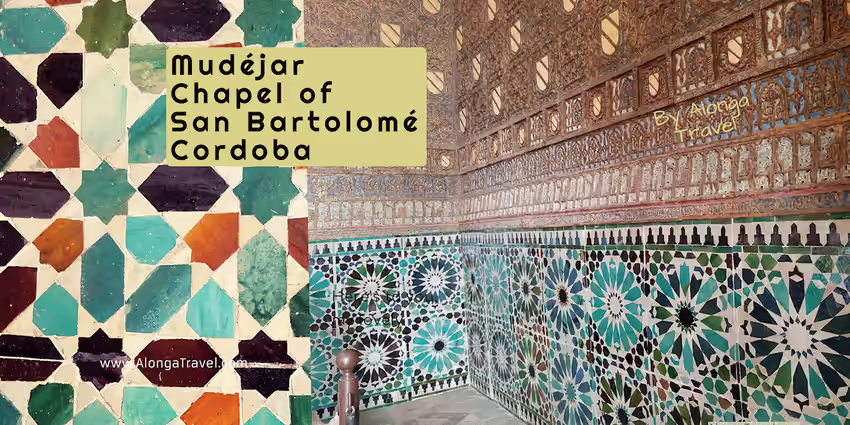
Did you like that Mudejar Chapel? I mean, who wouldn’t? Now, let’s return to the origin of the term – Mudejar and its history, as it is directly connected to the way Mudejar architectural style looks.
What is the origin of the Mudéjar?
The term “Mudéjar” [moo-the-hah-r] comes from the Arabic word mudajjan. It means “those who are allowed to stay”—a reference to the Muslim people who were allowed to remain in the Iberian Peninsula Christian territory under Christian rule, but didn’t convert to Christianity.
Read on for more details, and later read the detailed account of Muslim life in Spain, covering the period from the fall of Seville to the Christian reconquest in Harvey book ‘Islamic Spain, 1250 to 1500′.
Where the term Mudejar art come from?
The term Mudejar art was created by an art historian named José Amador de los Ríos y Serrano.
Historical context of Mudéjar art
Mudejar style architecture appeared during a period of cultural exchange between the Moorish Muslim rulers in Al-Andalus and the Christian rule settlers who had conquered much of the region by the late 11th century.
The last Muslim state in the peninsula was the Emirate of Granada, which was located in the southern Spain and fell to the Catholic Monarchs in 1492.
Gifted Islamic craftsmen continued their traditions working with decorative Islamic art motifs and patterns, but they started to apply them to traditional Christian architecture.
This exchange created a a distinct new style: a unique blend of architectural styles, with features of both Islamic architecture and Christian architecture together, that became known as Mudéjar style during the Middle Ages.
Mudejar architecture has most likely started in Toledo, taking after Mozarabic architecture that appeared there around 7th century, became popular around Aragon and Andalucia. It then spread to the rest of the Iberian Peninsula to the neighboring Portugal.
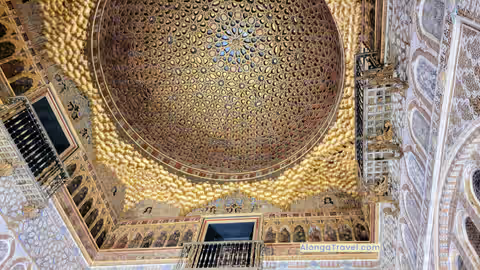
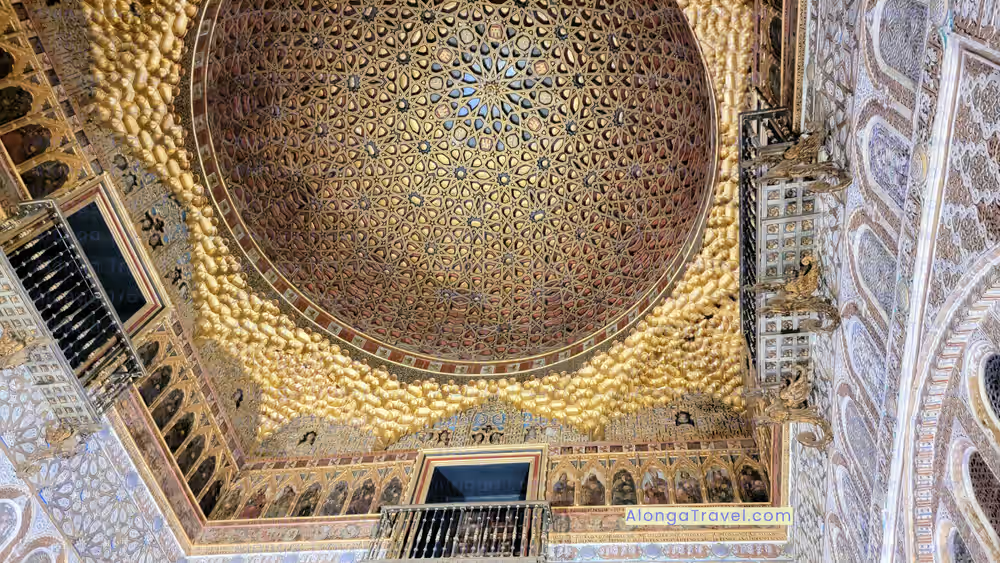
The Mudéjar style since then has been influential in many areas around the world, particularly in Latin America, where it was adopted by settlers from Spain during colonial times.
It has also been adapted into modern Islamic architecture in countries such as Morocco, Tunisia, and Turkey, making it a truly global influence.
Let’s see what characteristics define Mudejar architecture.
Combination of Islamic and Christian Styles of Architecture
Mudejar style was used as a way to integrate the two cultures, Islamic culture and Christian culture, and it features elements from both in unique ways.
You can see intricate geometric patterns, arabesques, carved intricate calligraphy inscriptions and star shapes. These elements reflect the influence of Islamic architecture.
At the same time, architectural features such as columns, domes, and arches have been used in Christian architectural styles traditionally.
This blend of two styles has created a distinct new style – Mudéjar.
Christian architectural styles that influenced Mudejar architecture
The Christian architectural styles that influenced Mudejar architecture include:
- Gothic
- Renaissance
- Baroque
Learn how these Christian architectural styles have influenced Mudejar style following this link or scrolling to the bottom of this post.
Key features of Mudéjar architecture
Key features of Mudejar architecture could be arranged into 3 key groups below.
3 Key Groups of Elements
1. Elaborate decorations.
2. Structural elements.
3. Distinct building materials. Mudéjar architecture is known for its brick walls covered in stucco or plaster, making the buildings durable and visually striking.
Let’s look at all of these elements in details.
Decorative Elements of Mudejar Architecture
There are some distinctive decorative elements in architecture built in Mudejar style, such as quatrefoils, star patterns, Kufic inscriptions, muqarnas, arabesques and ornate tiles on walls and ceilings.

Quatrefoils
Quatrefoils (four-petaled flowers) are geometric designs that feature four lobes or petals arranged into a symmetrical star-like shape.
Often seen as an ornamental motif on both the interior and exterior of buildings, quatrefoils can be found on walls, ceilings, doors or other architectural features.
Quatrefoils have originated from Islamic art and design and then adapted by Christian architects working in Mudéjar style during the Middle Ages.

ARABESQUE PATTERNS
Here is one of the Mudejar style element – arabesque pattern on Alcazar de Real in Spain. I loved it because it’s so old and authentic!
Arabesques refer to intricate, flowing patterns, often of foliage, and intertwining lines. They are commonly used in Mudejar architecture to create decorative motifs on walls, ceilings, and arches.

Arabesque patterns are often made up of geometric shapes, like circles and stars.
Aren’t they fun?!:)

Latticework
Latticework is a type of decorative feature often seen in Mudéjar style buildings, mostly on the windows and door frames.
Latticework is elaborate metal or wood carving interlocked to form geometric shapes. These shapes: stars, circles, squares and triangles add an extra layer of detail to the building’s interior or exterior.
This creates woodwork that not only astounding, but long lasting.
We all can just admire what the Islamic craftsmen of Andalusia created in 13th through 16th centuries, and the current Spanish and Portuguese’s Governments preserves!
This one of the reasons European destinations are so popular! They have timeless art to admire!


Kufic inscriptions
These are decorative Islamic calligraphy inscriptions in Kufic script, often used to embellish walls, ceilings, and arches in Islamic and Mudejar architecture.
Stalactite work
Stalactite work, also known as muqarna, is a unique architectural technique that involves creating ornamental designs using three-dimensional, hanging, and interlocking structures resembling inverted stalactites.
Used primarily in ceilings and vaults, stalactite work adds depth and complexity to Mudejar architectural designs.
Use of distinctive building materials.
Mudéjar architecture has its own distinct style of building materials.
Mudéjar buildings are often constructed with brick walls, covered with stucco or plaster. There is also ornate tile work to create intricate patterns and designs that can be seen on walls, ceilings, vaults, and other architectural elements.
This combination of building materials creates this distinctive style, typical of Mudejar style.
Tiles used in Mudejar architecture are typically made of glazed ceramic and are often brightly colored.
Mudejar Tiles
Looks at these staircases. Aren’t they fun?! 🙂

This staircase is from the Alcazar de Real in Seville, Spain.

Another staircase from Seville, Spain
Tiles were used to decorate walls, floors, and ceilings, and they were arranged in intricate patterns and designs. The patterns often include geometric shapes, floral motifs, and calligraphy, and are arranged in a way that creates a sense of harmony and balance.
Mudéjar style plaster
Mudejar architecture in medieval Spain and Portugal is famous for its use of Mudéjar style plaster.
This decorative plasterwork is known for its intricate patterns and carvings inspired by Islamic art. It is made by combining sand, limestone, gypsum powder, and water, which are then spread on walls or ceilings and carved into beautiful designs.
The plaster can also be enhanced with vibrant colors by adding different pigments.
Mudejar style plaster is versatile and widely used in modern architecture for both interior and exterior decoration. It adds elegance and charm to homes, hotels, and other buildings.
The unique combination of materials and decorative elements gives Mudéjar architecture its distinct appearance.

Structural architectural elements of Mudejar architecture
Mudejar architecture incorporates distinctive structural elements such as domes, arches and vaults. These elements add depth and complexity to the overall design.
Arches
Arches are a fundamental element of Mudéjar architecture; they are both decorative features and structural elements.
These arches create an open and airy feel that helps to bring light into the building and provides a sense of space.
Using multiple arches also allows for complex designs and inner courtyards, commonly found in Mudéjar buildings.

Horseshoe arch
Horseshoe arch is one of the typical arches in Mudejar style of architecture.
The horseshoe arch, also known as the Moorish arch and the keyhole arch, is a specific type of arch. It has a curved shape like a horseshoe and extends downwards beyond the flat line of its diameter. This means that the bottom opening of the arch is narrower than its full width.

Vaults
Vaults are another important element of Mudéjar architecture.
A vault is an arch-shaped structure that is used to span a space and provide support for the roof or ceiling of a building. They can often be seen on ceilings or walls, creating shapes that add depth to the design.
The vaults themselves can be constructed using different material like stone, steel, or other materials. They also provide stability while keeping the space open and airy.
Vaults are commonly seen in Mudéjar architecture as they help to keep the unique aesthetic of an Islamic-influenced building, while helping support large open spaces – domes.
Watch the video at the beginning of this post about Sant Bartholomew Chapel to see the best example of Mudejar vaults both on the ceiling and the wall.

Domes in Mudejar architecture
Domes were an important feature of Mudéjar architecture.
Domes are semi-circular or polygonal structures that provide strength and stability to a building, while at the same time creating an impressive aesthetic when adorned with decorative motifs.
Use of intricate wood carved work in domes made domes decorative and stronger! Domes are key element of the Mudéjar style.
Contribution of Jewish culture to Mudejar style
Do you know that besides being a blend of both Islamic and Christian cultural features together, Mudéjar style of architecture has also some Jewish influences?
That happened because of the Spanish diverse population back in medieval times that were all living and building, and creating peacefully together.
Read more about contribution of Jewish culture to Mudejar architecture in my other post.
This rich cultural exchange helped shape the Mudéjar style of architecture and made it a unique symbol of Spain’s multicultural heritage and Spanish architecture.

Neo-Mudéjar

What is the meaning of Neo-Mudéjar?
Neo-Mudéjar is a contemporary interpretation of Mudéjar art styles that were prevalent in Spain and Portugal during the late 19th and early 20th centuries. This artistic style incorporates traditional Mudéjar elements like arches, tiling, and brickwork, alongside modern materials such as cast iron and glass.
As this style has been gaining popularity in the region, some Spanish architectural companies have taken these designs to the Arabic-speaking countries of Morocco, Algeria, and Eastern Arabia.
As well as impacting architecture from the West to the East, Mudéjar characteristics have been influencing modernizing styles across many different countries.
Muslim architects are embracing technical advances while also keeping true to their aesthetic expertise reminiscent of Mudéjar styles and art. It’s inspiring how they stay true to traditional forms while at the same time innovating new designs that continue to be sought after both locally and worldwide.
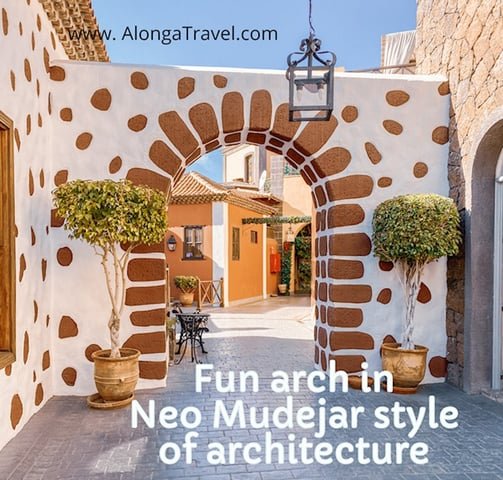
For those interested in architecture: more details on how these Christian styles influenced Mudejar architecture
Gothic
Gothic architecture started in Europe in the late 12th century and lasted until the 16th century. It was influenced by Romanesque and Byzantine art, and showed the religious and artistic ideas of the Middle Ages.
Some things that Mudejar architecture took from Gothic architecture are pointed arches and ribbed vaults. But Mudejar architecture is different because it uses materials and techniques from Islamic tradition like bricks and glazed tiles. It also has horseshoe arches and square towers, which are not found in Gothic architecture.
In the Gothic-Mudejar style, you will see brick and glazed tiles used to decorate walls, arches, and vaults.

An angled entryway, typical of the Gothic style, surrounded by Moorish tiles results in Mudejar style element. This picture is from my visit of Sintra National Palace.
Renaissance architecture
Renaissance architecture is a style that revived the classical elements of ancient Greece and Rome. It was popular in the 16th century. You can see symmetry, proportion, and harmony in this architecture in Italy and other parts of Europe.
Renaissance-Mudejar style
This style was a fusion of Mudejar and Renaissance elements.
Mudejar architecture “borrowed” the use of columns, arches, domes, and vaults from Renaissance style.
Buildings in this resulting Renaissance-Mudejar style style feature ornate woodwork, intricate plasterwork, and tilework.
Baroque architecture
Baroque architecture is a style that took the naturalistic and theatrical aspects of the Renaissance to the next level. It was popular in Italy and other parts of Europe.
This style is known for its emphasis on contrast, light, motion, and ornamentation. Baroque architecture is characterized by curved and twisted forms, intricate scrolls, and the use of sculptures. It is often seen in the design of churches and palaces.
Baroque-Mudejar style
Baroque-Mudejar style emerged in the 17th century. It used many decorative elements of Baroque architecture, in addition to its own characteristics. The resulting Baroque-Mudejar style was characterized by the use of polychrome ceramic tiles and colorful decoration.
The Royal Chapel of Granada and the Palace of the Marquis of la Vega Inclan in Sevilla are examples of this style.
Elaborate decorations and Moorish tiles result in Mudejar style element.

Mudéjar style around the world
Mudéjar style has spread globally over centuries, influencing various architectural styles, like the 19th century Neo-Mudéjar style.
In Latin America, Mudéjar architecture is prominent in colonial cities like Mexico and Peru, featuring bright colors, geometric patterns, and intricate details.
In the Middle East, modern materials like steel and glass have been incorporated into Mudéjar styles while maintaining traditional decorative motifs.
It is an important part of Spanish architectural history and has influenced architecture worldwide, therefore it’s crucial to preserve Mudéjar buildings for their beauty and historical significance.
When visiting regions with Mudéjar architecture, take time to admire this wonderful architecture, knowing many things about it now.
I wanted to show you cities with the best examples of Mudejar architecture here, but this post is getting too long. I made a separate post for all the wonderful cities in Spain where you can see it. Here, I will mention one prominent examples in another country – Portugal.

Sintra National Palace is a great example of Mudejar architecture in Portugal
Sintra National Palace is a beautiful example of Mudejar Architecture in Portugal, and is not to be missed! Learn my detailed description of that awesome palace in Sintra, Portugal in my other post.
Let’s connect on social media!
Found this post helpful? Please, consider supporting my work and the website maintenance cost, thank you!
Subscribe to my periodic newsletter for my new posts. New here? Visit my main Alonga Travel page.

